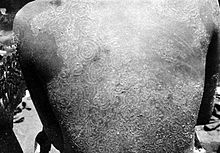Tinea imbricata
| Tinea imbricata | |
|---|---|
| Other names | Tokelau[1] |
 | |
| Tinea imbricata | |
| Specialty | Dermatology |
Tinea imbricata (also known in parts of Indonesia as “Kaskado”) is a superficial fungal infection of the skin limited to southwest Polynesia, Melanesia, Southeast Asia, India, and Central America.[1]: 303 [2] The skin lesions, often itchy, occur mainly in the torso and limbs.[3] The name tinea imbricata is derived from the Latin for "tiled" (imbricatus) since the lesions are often lamellar.[4] The lesions are often treated with griseofulvin or terbinafine.[4]
The condition has also become known as "Tokelau" - the name apparently references the islands of Tokelau in the South Pacific.[5]
The risk of developing tinea imbricata is probably inherited as an autosomal recessive trait.[6][7]
Tinea imbricata is associated with Trichophyton concentricum.[4]
Tinea pseudoimbricata
The term "tinea pseudoimbricata" synonymous with "tinea indecisiva", was coined to describe a form of tinea mimicking the concentric rings of tinea imbricata, but is caused by local or systemic immunosuppression.[8] Since then, 3 cases of Trichophyton tonsurans have been associated with it,[9] as well as Trichophyton rubrum which can trigger mycosis fungoides.[10][11] Mixed infections with scabies have been described to produce tinea pseudoimbricata.[12][13]
As of 2015 in India, corticosteroid–antifungal–antibacterial combinations sold as over-the-counter drug have led to an increase in chronic, recurrent, difficult to treat fungal infections of the skin, including tinea pseudoimbricata.[14]
See also
- Skin lesion
- List of cutaneous conditions
References
- ^ ISBN 0-7216-2921-0.
- ISBN 978-1-4160-2999-1.
- PMID 27959674.
- ^ S2CID 45272404.
- ^
ISBN 9783663141327. Retrieved 7 March 2024.
Reisenden in pazifischen Länder fällt häufig eine Hautpilzerkrankung der Einheimishen auf, die insbesondere in den feuchtheissen Küstenzonen vorkommt [...]. Die gängigen dermatologischen Bezeichnungen für diese Hautinfektion sind Tinea imbricata und Tokelau. Die Bewohner der Tokelau Gruppe nördlich von Samoa waren möglicherweise besonders häufig von der Tinea imbricata betroffen, so daß ihre Insel zum Synonym für diese Trichophytie wurde.
- S2CID 27447510.
- PMID 7218274.
- S2CID 30983522.
- ^ Ouchi T1, Nagao K, Hata Y, Otuka T, Inazumi T. Trichophyton tonsurans infection manifesting as multiple concentric annular erythemas. J Dermatol. 2005 Jul;32(7):565-8.
- S2CID 208341303.)
{{cite journal}}: CS1 maint: multiple names: authors list (link - S2CID 31276542.
- ^ Poziomczyk CS, Köche B, Becker FL, Dornelles SI, Bonamigo RR. Tinea pseudoimbricata caused by M. gypseum associated to crusted scabies.An Bras Dermatol. 2010 Jul-Aug;85(4):558-9.[English, Portuguese]
- PMID 27506504.
- PMID 29485088.
